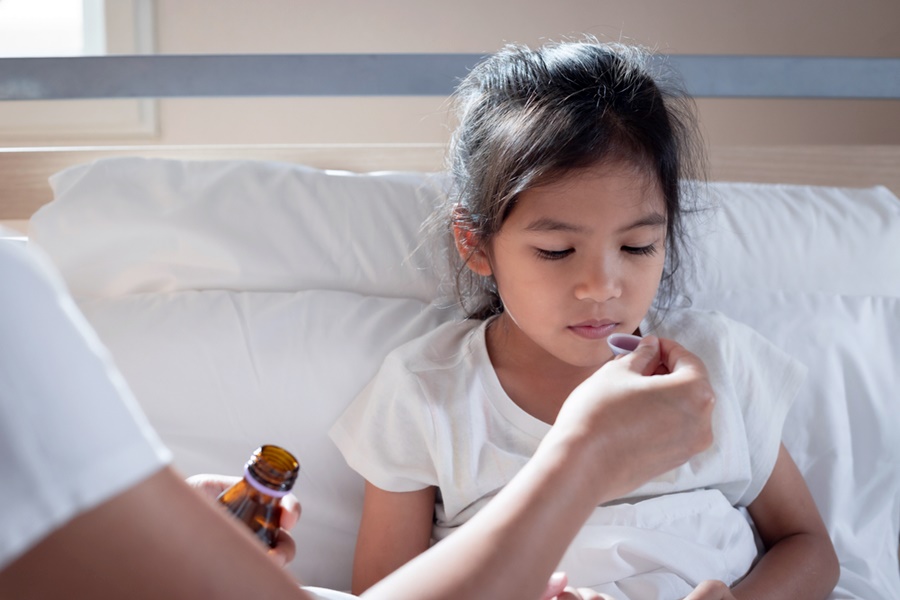Sep-Oct 2024 Reminder





Source: Psychiatrist Dr. Wong Chun Yin
As parents, we have to juggle work and family responsibilities. Under significant stress, it’s easy to experience anxiety. Anxiety is a natural, built-in response, and it can protect us when our lives are threatened. However, excessive worry can lead to physical discomforts like a racing heart, stomachaches, muscle tension, rapid breathing, headaches, trembling hands, sweating, or frequent urination. If not addressed in a timely manner, it can lead to more serious emotional issues and can also affect family relationships.
Here are three ways to reduce anxiety symptoms. First is practicing relaxation through deep breathing, using diaphragmatic breathing. Inhale slowly through your nose for a count of 4, letting your abdomen rise for 2 seconds, then exhale slowly through your mouth for a count of 4. Pause for 2 seconds and repeat this process 5 to 10 times.

The second method is muscle relaxation exercises. Find a comfortable place to sit or lie down, gently close your eyes, and relax all your muscles. Start by shifting your focus to your feet, tense the muscles in your feet for 10 seconds, and then release. Proceed sequentially, tensing and relaxing the muscles in your legs, arms, neck, and facial muscles.
Lastly, there is imagery relaxation practice. In a quiet place, close your eyes and imagine a comfortable setting, visualizing what you see, hear, smell, and feel for 5 to 10 minutes. Gradually return to the present reality.
Additionally, it’s important to cultivate a positive thinking pattern in your daily life. Try to see the bright side of things at all times rather than dwelling on unhappy thoughts constantly, which can reduce the chances of developing mood disorders.


Source : Chinese Medicine Practitioner, Chiu Shi Cheung
Many children today spend a lot of time looking at computers, phones, or reading, which can strain their eyes. There are some acupoint massages that can help children relieve eye strain.
The first acupoint we’ll introduce is the “Zan Chuk” point. It’s located at the very front end of the eyebrows, about half an inch downward, at the corner of the eye socket. Another acupoint is called the “Jing Ming” point. It’s located at the side of the nasal bridge, right in the middle between the two eyes, near the inner edge of each eye. The third point is the “Si Pak” point, which is about 1 inch below the eyes, roughly the width of two fingers apart. It’s in front of the cheekbone, and when you touch it, there should be a slight depression just below the eyes; this is the “Si Pak” point. The last acupoint is the “Shi Chuk Hung” point, located at the very end of the eyebrow. All four of these points can help with dispersing wind, clearing heat, and improving vision.
Once we know the locations of these acupoints, how do we massage the eye area?
First, let’s start with the first point, the “Zan Chuk” point. You’ll use your four fingers to hold down the eyebrows, and then use your thumb to press on the “Zan Chuk” point. The “Zan Chuk” point is right at the very front end of the eyebrows, in the depression at the corner of the eye socket. Hold it with your four fingers and your thumb, and gently rotate 64 times in opposite directions.
The second acupoint is called “Jing Ming” Point, located in the area in front of the inner corner of the eye, between the eyebrow and the bridge of the nose. We use two fingers to gently pinch the bridge of the nose and then slowly massage it up and down, repeating this motion 64 times.

The third acupoint is called “Si Pak” Point. It is located on the inner edge of the cheekbone on our face. In fact, when you touch it, you’ll feel a slight depression. Using two fingers, place them on either side of the bridge of the nose, and you will be able to locate this point. Gently press inside, and you will feel a slight soreness. After locating it, you can also rotate the pressure 64 times.
The fourth acupoint is Shi Chuk Hung Point. To locate it, use your thumbs to first press on both sides of the temples. Then, starting from the Shi Chuk Hung Point, sweep upward to the Shi Chuk Hung Point again, and then continue downward, below the eyes, to the Shi Chuk Hung Point. This constitutes one cycle, and repeat this motion 64 times.
By massaging these four acupoints, you can not only relieve eye fatigue but also improve the blood circulation around the eyes and prevent eye conditions such as nearsightedness. When we do eye exercises, remember to keep our eyes closed throughout the entire process. After completing the eye exercises, it’s also important to keep your eyes closed for 2 to 5 minutes. We typically press each acupoint for 64 times. Why 64 times? It’s because, from the perspective of Traditional Chinese Medicine “eighty-eight sixty-four“, we call it the “first of eight eights” meaning the most important.


Written by:Dr. Wilbert Law, an assistant professor in the psychology department at Hong Kong University of Education and a registered educational psychologist.
How do parents react when their children coax and pamper them, ask for different things, or play with them in a baby-like voice? Do you think children are troublesome? Or do you feel that your child is just messing around, doing nothing serious?
But why will children pamper? Research has shown that adults are particularly sensitive to the sound of pampering, so it is easier to catch their attention. It is possible that the child is pampering his parents because he needs your attention at that moment. Sometimes adults are so busy with their lives that they may neglect them, so children will pamper their parents when they see them.

How can parents respond when their children are pampering their parents? In fact, when we understand the possibility of our children’s pampering, we know that they are not deliberately provoking parents, they can try to sit down and talk with their children to understand their needs, especially if the child is pampering because he or she is tired. We can help them express themselves with some words. For example, ask your child, “How do you feel?” “Are you very tired?” “What can I do for you?”
Of course, you may also want to reduce your child’s pampering behavior by encouraging them more, using age-appropriate words and behaviors, and praising and affirming them more often. When they are pampering you, do not scold or mock them.


Written by: Family Dynamics Founder, Marriage and Family Therapist, Ms. Ng Yee Kam
As a child grows up and interacts with the environment and people around him or her, he or she will gradually develop some feelings. Children will use these feelings to choose what they like or dislike, which is normal development for children. Mom says that her son is beginning to have an opinion, which means that he is expressing these feelings and that he has his own choices. Mom found out that his choice was not to choose herself but to choose Dad to play and read books with him.
There is a possibility that the son likes books and toys, that may not be the kind that his mother chooses, so he slowly begins to think that his mother may not be the right person to play with him. So the content of the play may be one of the reasons. Mothers can try to give their children more space to choose the toys they like to play with when they play with them. For example, sometimes our son likes to read a book, and he may look through it many times, so we can give him some space. Even when he likes it, we can continue to let him read the book, continue to talk to him about the book, and give them some space to choose for themselves!

Another possible reason is attitude. First of all, the mother can observe if she makes the child feel comfortable, happy, and joyful when playing with him, or if she is very nervous when playing and has to worry about him doing this and that—a lot of regulation—or if the mother is always leading him and giving him instructions, or if she unknowingly quizzes him during play: “How do you call this?” and “What color is this?”, “What is this symbol?”, “What is this mark?”
When playing, we need to let go of these so-called educational ideas, we don’t need to be strict and serious, so that we can build a happy and enjoyable experience for our children. Children need to be relaxed when they play. We don’t want to test them, we want them to have their own space and freedom of choice, and this is real play.
Once he chooses what he likes to play with and how he likes to play, Mom can try to observe these two aspects and see if there is room for improvement. At the end of the day, there may be nothing wrong with the mother, but the father is a master at playing games with the children, which is why they love him so much.

Some adults are really attracted to children, and it’s a good thing if fathers can play so well with their children, so mothers really don’t need to be too concerned. If a mother feels lost or depressed because her children do not choose her, she should investigate whether there are aspects of her life that are not as good as she would like, such as feeling lonely, and the company of her son becomes very important to her. If this is the case, the mother needs to address her needs or seek help.




Source: Senior Dietitian, Ng Yiu Fun
Many parents ask me, “Does my child need to take supplements?” For example, would fish oil or DHA be better for him? I have children myself, and I don’t let them take any supplements. But some parents say, “Is it really smarter to take supplements?”
In fact, if you have a balanced diet, you don’t need any supplements. Why? For example, if you take too much fish oil, it will have an excessive blood-thinning effect, and you will easily bleed out. So we say that if you take too much fish oil, it may not be good for your child.
We may have to figure out how to add a little bit of fish to our food. For example, if he doesn’t like eating fish, we can dip the fish in batter and bake it to make it feel crispy and tasty. Or when cooking spaghetti, you can add some crustaceans, such as clams, which are easy for children to absorb. Also, simple foods such as seaweed have ingredients that make them smarter.

As for the parents, they may think that if they take more calcium supplements, their children will grow taller. This is also not necessary, because if you take too many calcium tablets, it will be very easy to give him kidney stones. We can let children drink milk, tofu, or soy milk to help them absorb calcium without the need for special supplements.


Written by: Doctor Cheung Kit
If a child is seriously ill, I think the parents’ suffering is also significant. This is because, in addition to taking the child to see a doctor and taking time off to care for the child, they also worry about giving the child medication. Therefore, the real battle often begins after returning home from the doctor. There is a systematic approach to administering medication to children, and parents can learn how to do it.
First, the initial form of medication that children encounter is liquid. Liquid medication can be divided into two types: solution and suspension. The former is a watery preparation, often containing a small amount of alcohol, while the latter does not contain alcohol but has granular suspended particles, which can be felt in the throat. Both types are equally effective and have their supporters. Doctors generally have both types of medication available.

Due to the medicinal taste, children do not like it. If you plan to add the medicine to a flavored drink to mask the taste, it generally fails because children are very likely to notice. Furthermore, children have a natural aversion to nausea, so when they feel the discomfort of the medicine in their throat, they may vomit it out. There is no distinction between taking children’s medicine on an empty stomach or after a meal. However, some medicines may react with food, for example, tetracycline and erythromycin in antibiotics may interact with milk, affecting their effectiveness.
As for pills or capsule medication, it’s better to wait until the child is a little older to try them. In theory, both are equally effective compared to liquid medicine. However, generally, cough syrups contain a variety of functional ingredients, making them more effective. Therefore, adults also consider prescription cough syrups. As for the age at which prescription pills can be taken, it depends on the child’s acceptance, as some adults may not even swallow pills. So, as parents, how can we make the process of administering medication less of a chore?

● Try not to force the child to swallow the medicine.
● Involve the child in the process of taking the medicine as early as possible, such as getting the medicine, pouring the liquid, and eventually self-administering with a spoon.
● If the child vomits heavily within half an hour of taking the medicine, you can administer another dose.
● It’s best not to mix the medicine with milk, as if the child doesn’t finish the milk, they won’t get the full dose of the medicine.
● Encourage the child to try swallowing pills (no age limit), starting with a small one.
● Suppositories are indeed effective for certain oral medications. However, for many sensible children, this is a “painful” experience and can lead to negative associations, so it’s best to avoid it if possible.
● Parents should also have a positive attitude towards taking medicine: getting sick requires taking medicine, and taking medicine is not a chore.
We hope that all parents will not be troubled by their children taking medicine.


Source: Senior Parenting Expert, Bally
Many parents often ask, “Why is the child so disobedient?” “Why does he hate me so much?” or “He is ignoring me more and more.” In fact, there are four types of behaviors that, over time, will cause our children to despise themselves. Many of the parents that I have met in my day-to-day life often unconsciously say or do things that make their children hate themselves. This is what parents do not notice.
First, comparison. We frequently ask children, “Why are you like this?” “Your younger brother is not like you; he is very neat,” and “look at the students next to me; they listen to their parents. “When we often express ourselves in a “comparison” manner, children will feel disgusted when they hear their mother’s voice.
Secondly, when children do something wrong, parents often overlook the motives behind their behavior. When we find out that a child is doing something wrong, we should first understand what the child is trying to accomplish with the behavior. Do not rule out that they are trying to do something right. Maybe he wants to pour a glass of water for his parents or his brother, or he is not doing his homework well, but in fact, he is doing his best and is just mentally tired.

When he is not doing well, we can first praise his behavior by saying, “Thanks; I know you are nice and want to pour water for us, but don’t spill water again.” “It’s dangerous,” or “Don’t walk so fast.” After we praise the child, he will understand that he is doing the right thing, and then he will listen to his parent’s advice and improve.
Third, parents should pay attention to the end of the day if, in fact, they are full of negative energy and bring emotions into the home. When parents see that their children are not behaving in a satisfactory manner, they may take out their emotions on them in a series of ways. This is not fair to the child, who may have made only a few mistakes but is being blamed for a series of them.

Fourth, parents should be very careful that expressions of anger will misinform their children with inaccurate information. For example, “If you do this, you might not be my son.” When we mistakenly use such an aggressive word, it can be very harmful to the child.
Parents should never commit these four behaviors while children are growing up, or they will hate their parents from an early age.


Source: Psychotherapist, Lee Wai Tong
The parents begin feeding the baby milk and gradually introduce paste from the time the baby is born. Then children can start to hold their own utensils and eat on their own, one bite at a time while watching them grow up. But when the children reach the age of 6 to 7, they will suddenly ask their parents to feed them. What is the reason for this? How can this be resolved?
Whenever children grow up, their parents are happy, especially when their children eat. In the past, they had to be fed by their parents, but later they learned to use utensils and eat by themselves, which was originally a very happy thing. However, many parents do not understand that when children can eat on their own, they begin to ask their parents to feed them. This is because the intimacy of parental feeding feels good and may make children want to be fed.

When children are young, it is fun for parents to feed them, but when children grow up, it is a headache for parents if they still want to be fed halfway through a meal. We don’t want to spoil the atmosphere of the meal because of the feeding problem, so we need to learn that when children ask to be fed in the middle of a meal, we can solve the problem in the following ways:
Parents can say to their children, “If you take two more bites of rice, mommy and daddy will start feeding.” The next time the same thing happens, say, “If you eat three more bites, mommy and daddy will start feeding,” gradually shorten the time of parental feeding, and gradually extend the time of children eating on their own. Later on, there is a chance to finally just feed him a bite to maintain the intimacy of the parent-child relationship but also to make the eating atmosphere more interesting.
Address: G/F WING B & C, SAU YUE HOUSE SAU MAU PING ESTATE KOWLOON
Fax: +852 2709 9269